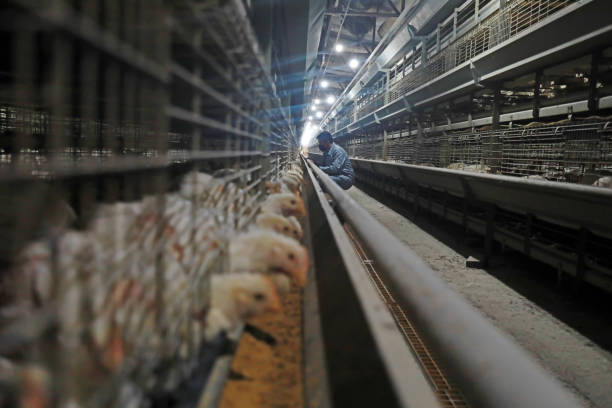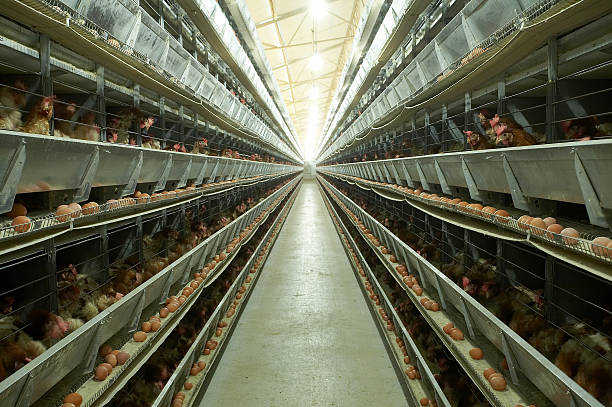
Uganda Layer Project: Maximizing Egg Production with Battery Cages
Uganda Layer Project: Maximizing Egg Production with Battery Cages
The Ugandan poultry industry is experiencing a significant upswing, driven by increasing domestic demand for eggs and a growing awareness of the nutritional benefits of poultry products. For aspiring and established poultry farmers in Uganda, optimizing egg production is paramount to achieving sustainable profitability and contributing to national food security. One of the most effective methods for maximizing egg yield is the implementation of a well-designed layer project utilizing battery cages. This article delves into the intricacies of such a project, exploring the advantages of battery cages, essential considerations for setup, management best practices, and the overall impact on the Ugandan poultry landscape.
Understanding the Advantages of Battery Cages in Uganda
Battery cages, also known as layer cages, are a housing system designed to optimize egg production by raising chickens in individual or small group compartments. In the context of Uganda, where land and resources can be limited, and operational efficiency is crucial, battery cages offer several key advantages.
Increased Egg Production: The primary benefit of battery cages lies in their ability to significantly boost egg production. By providing a controlled environment with optimized lighting, temperature, and ventilation, hens are less stressed and more likely to lay consistently. This translates to a higher number of eggs per hen compared to free-range or deep litter systems.
Improved Hygiene and Disease Control: Battery cages minimize contact between hens and their waste, reducing the risk of disease outbreaks and parasitic infestations. The elevated wire mesh floors allow droppings to fall away, preventing the buildup of ammonia and bacteria that can compromise flock health. This results in lower mortality rates and reduced reliance on antibiotics, contributing to safer and more sustainable egg production.
Efficient Space Utilization: Battery cages allow for a higher stocking density compared to other housing systems, maximizing the number of hens that can be accommodated in a given area. This is particularly important in Uganda, where land is a valuable resource. With strategically designed cage layouts, farmers can significantly increase their egg production capacity without expanding their land footprint.

Reduced Labor Costs: The automated features of modern battery cage systems, such as automatic feeding, watering, and egg collection, can significantly reduce labor requirements. This frees up farmers to focus on other critical aspects of farm management, such as monitoring flock health, managing feed supplies, and marketing their eggs. In a country where labor costs can be a significant expense, this can translate to substantial savings and improved profitability.
Better Feed Conversion Ratio: Battery cages allow for better control over feed distribution, ensuring that each hen receives an adequate and consistent supply of nutrients. This reduces feed wastage and improves the feed conversion ratio, meaning that hens are able to convert feed into eggs more efficiently. This is a crucial advantage in Uganda, where feed costs can be a major expense for poultry farmers.
Essential Considerations for Setting Up a Battery Cage Layer Project in Uganda
Setting up a successful battery cage layer project in Uganda requires careful planning and attention to detail. Here are some essential considerations:
Site Selection: The location of your poultry farm is critical to its success. Choose a site that is easily accessible by road, has a reliable source of clean water, and is free from noise and pollution. Consider the prevailing winds and drainage to minimize the risk of odor and water contamination. Also, proximity to markets and suppliers of feed and other inputs should be taken into account.
Cage Selection: Choosing the right type of battery cage is crucial for optimizing egg production and ensuring hen welfare. Consider the number of hens you plan to house, the available space, and your budget. There are various types of battery cages available, including A-frame cages, H-frame cages, and flat-deck cages. Evaluate the features of each type, such as cage size, ventilation, feeding and watering systems, and egg collection mechanisms, to determine which best suits your needs. Galvanized or stainless steel cages are excellent choices due to their resistance to corrosion, which is very practical in the frequently humid weather conditions of Uganda.
Housing Design: The poultry house should be designed to provide a comfortable and safe environment for the hens. Ensure adequate ventilation to remove moisture and ammonia, and provide natural light to stimulate egg production. Insulate the roof and walls to maintain a consistent temperature inside the house, especially during extreme weather conditions. Implement biosecurity measures, such as foot baths and fencing, to prevent the entry of disease-carrying organisms. You’ll need to plan for proper waste management as well, making sure waste can be moved away from the poultry house and converted into fertilizer.
Feeding System: An efficient feeding system is essential for ensuring that hens receive an adequate and consistent supply of nutrients. Automatic feeding systems can significantly reduce labor requirements and minimize feed wastage. Ensure that the feed troughs are properly designed and positioned to prevent spillage and contamination. Work with a reputable feed supplier to develop a balanced ration that meets the specific nutritional needs of layer hens at different stages of production.
Watering System: Access to clean, fresh water is essential for hen health and egg production. Nipple drinkers are a popular choice for battery cage systems, as they provide a continuous supply of water while minimizing wastage and contamination. Regularly check the watering system to ensure that it is functioning properly and that all hens have access to water.
Lighting Program: A well-designed lighting program is crucial for stimulating egg production. Layer hens require a minimum of 16 hours of light per day to maintain optimal egg laying rates. Supplement natural light with artificial light during the shorter days of the year. Use timers to automate the lighting program and ensure consistency.
Waste Management: Proper waste management is essential for maintaining a clean and healthy environment and preventing the spread of disease. Collect droppings regularly and dispose of them in an environmentally responsible manner. Composting is a popular option for converting poultry waste into a valuable fertilizer.
Management Best Practices for Maximizing Egg Production

Once your battery cage layer project is up and running, it is important to implement management best practices to maximize egg production and ensure the long-term health and profitability of your flock.

Flock Health Management: Implement a comprehensive flock health management program to prevent and control disease outbreaks. Vaccinate hens against common poultry diseases, such as Newcastle disease and infectious bronchitis. Regularly monitor the flock for signs of illness and isolate any sick birds immediately. Consult with a veterinarian to develop a treatment plan for any diseases that occur.
Feeding Management: Adjust the feed ration according to the age and production stage of the hens. Provide a balanced diet that meets their specific nutritional needs. Monitor feed consumption and adjust the feeding program as needed. Ensure that hens have access to fresh, clean water at all times.
Egg Collection and Handling: Collect eggs frequently to prevent breakage and contamination. Handle eggs carefully to avoid cracking or bruising. Store eggs in a cool, dry place to maintain their quality and freshness. Grade eggs according to size and quality and package them properly for sale.
Record Keeping: Maintain detailed records of egg production, feed consumption, mortality rates, and other important parameters. This information will help you identify trends and make informed decisions about flock management. Analyze the data regularly to identify areas for improvement.
Staff Training: Provide adequate training to your staff on all aspects of poultry management, including feeding, watering, health management, and egg collection. Ensure that they understand the importance of biosecurity and hygiene. Empower them to identify and report any problems or concerns.
Monitoring and Evaluation: Regularly monitor the performance of your layer project and evaluate the effectiveness of your management practices. Identify areas where you can improve efficiency and reduce costs. Adapt your strategies as needed to maximize egg production and profitability.
The Impact of Battery Cage Systems on the Ugandan Poultry Landscape
The adoption of battery cage systems has had a significant impact on the Ugandan poultry landscape, contributing to increased egg production, improved food security, and economic empowerment for farmers.
Increased Egg Availability: Battery cage systems have enabled farmers to significantly increase their egg production capacity, leading to increased availability of eggs in the market. This has helped to meet the growing demand for eggs in Uganda and reduce reliance on imports.
Improved Food Security: Eggs are a valuable source of protein and essential nutrients. Increased egg production has contributed to improved food security in Uganda, particularly for vulnerable populations such as children and pregnant women.
Economic Empowerment: Poultry farming can be a viable source of income for farmers in Uganda, particularly in rural areas. Battery cage systems have enabled farmers to increase their egg production and profitability, leading to economic empowerment and improved livelihoods.
Job Creation: The expansion of the poultry industry has created job opportunities in various sectors, including feed production, equipment manufacturing, transportation, and marketing. This has contributed to economic growth and development in Uganda.
Challenges and Considerations
While battery cage systems offer numerous advantages, it is important to acknowledge the challenges and ethical considerations associated with them. Animal welfare concerns are often raised regarding the confinement of hens in cages. It is important to address these concerns by implementing best practices for hen welfare, such as providing adequate space, enriched environments, and proper lighting and ventilation.
Furthermore, the disposal of poultry waste can pose environmental challenges. Proper waste management practices are essential to minimize the risk of pollution and protect the environment.
Looking ahead, the future of battery cage layer projects in Uganda is promising. With continued investment in infrastructure, technology, and farmer training, the poultry industry can continue to grow and contribute to the country’s economic development and food security. Furthermore, continued adherence to animal welfare, environmental protection, and biosecurity will ensure the sustainability of the industry.
